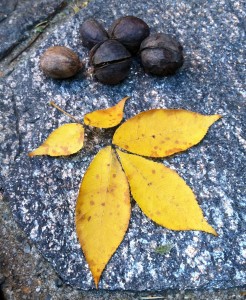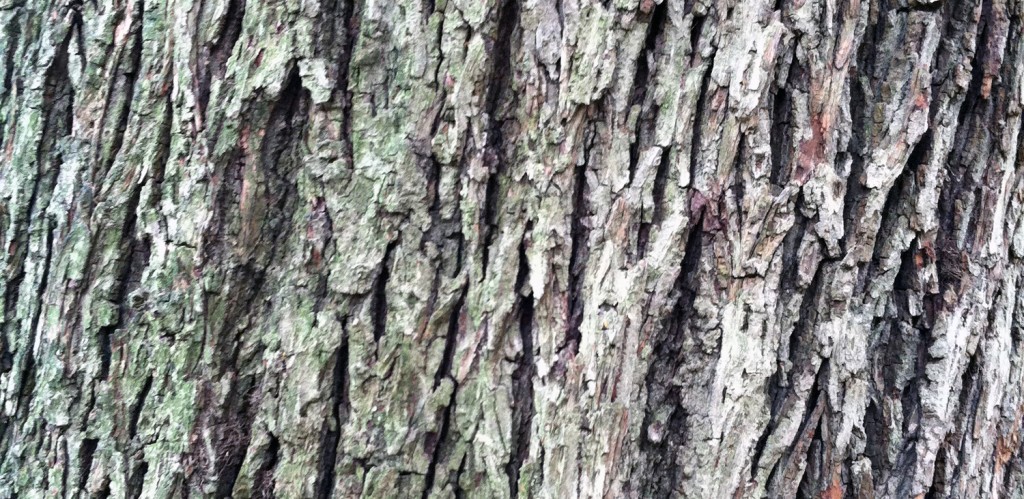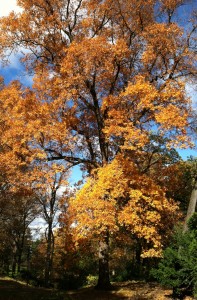John’s Tree
Posted in Gardens and Collections on December 4 2012, by Matt Newman
Sonia Uyterhoeven is the NYBG‘s Gardener for Public Education.
 I spend a lot of my time working with John Egenes in the Native Plant Garden. John is the gardener in charge of the area and his discerning eye doesn’t miss an inch of the vast new landscape.
I spend a lot of my time working with John Egenes in the Native Plant Garden. John is the gardener in charge of the area and his discerning eye doesn’t miss an inch of the vast new landscape.
I recently discovered that one of his passions is native trees. One day, during the height of fall foliage, he rattled off some of his favorite trees while pointing out the merits of both foliage and form. One of them–the pignut hickory (Carya glabra)–is situated just outside the Rock Garden, close to the rear service entrance.
The pignut hickory is a close relative to the famous pecan tree (Carya illinoinensis), responsible for your holiday pecan pie. But unlike the pecan, the nuts that the pignut provides are not so palatable. In fact, the name “pignut” is derived from the fact that the nuts are only suitable for swine. In nature, these are a valuable food source for many woodland creatures such as black bears, raccoons, squirrels, blue jays, foxes, rodents, and deer.
While the pecan makes it home in southern states, the pignut hickory is abundant in the northeast. It is an adaptable tree that thrives in dry woods and on hillsides as well as in moist, well-drained soils. Because the pignut hickory has a deep taproot, it can also withstand drier conditions than many trees because it can reach far down into the soil in search of moisture.
Pignut hickories are often found growing in the woods together with oaks. In this woodland environment, the nuts fall around the base of the tree, and generally germinate close to their mother unless carried off by a squirrel or other critter. With restricted light, the seedlings stay small. If they are browsed by deer or damaged by fire, they simply re-sprout since their root system is established. They sit and wait, putting their energy into a healthy root system, remaining small in stature until a violent storm comes along, similar to the hurricane that we experienced in October, and knocks down mature trees. When large trees fall, leaving gaps in the canopy, the saplings kick into life and grow 2 to 3 feet per year to fill in the open spaces above. Due to their established root system, the saplings grow much faster than any newly deposited seed. It is a great way to ensure the survival of its species.

Hickories are sought after as a source for lumber, as well. It is a strong, resilient wood that is used to manufacture tool handles, furniture, and since the wood is dense and able to bend, it was historically used to make wooden wheels. These qualities also make it a durable specimen for your garden. Hickories will weather most storms better than the majority of the trees in your garden.
 None of these is the reason why my colleague John loves this tree, however. It has endeared itself to him due to its beautiful upright form that billows in a graceful manner with a wavy, cascading crown and a tall straight trunk. The bark is a beautiful, deeply ridged silver gray-brown. It has pinnately (feather-like) compound leaves with 5 to 7 leaflets. In the fall, the foliage turns a brilliant honey yellow–when the sunlight catches it, it lights up with apricot overtones. For John, its appeal comes from its aesthetic and not its utility, although the latter is equally impressive.
None of these is the reason why my colleague John loves this tree, however. It has endeared itself to him due to its beautiful upright form that billows in a graceful manner with a wavy, cascading crown and a tall straight trunk. The bark is a beautiful, deeply ridged silver gray-brown. It has pinnately (feather-like) compound leaves with 5 to 7 leaflets. In the fall, the foliage turns a brilliant honey yellow–when the sunlight catches it, it lights up with apricot overtones. For John, its appeal comes from its aesthetic and not its utility, although the latter is equally impressive.
If you are in the Garden for the Holiday Train Show, or visiting to tour our magnificent Manolo Valdés sculptures, make time to stop by the Ross Gallery to see our exhibit on Magnificient Trees of The New York Botanical Garden. You will see a lovely photograph of the pignut hickory taken by photographer Larry Lederman, in its full fall glory.


thoroughly enjoyed reading this post….very informative with great illustrations..love the composition of leaf and nut. A few weeks ago the New York Times had a wonderful article about the NYBG confirs…by any chance did you read it?